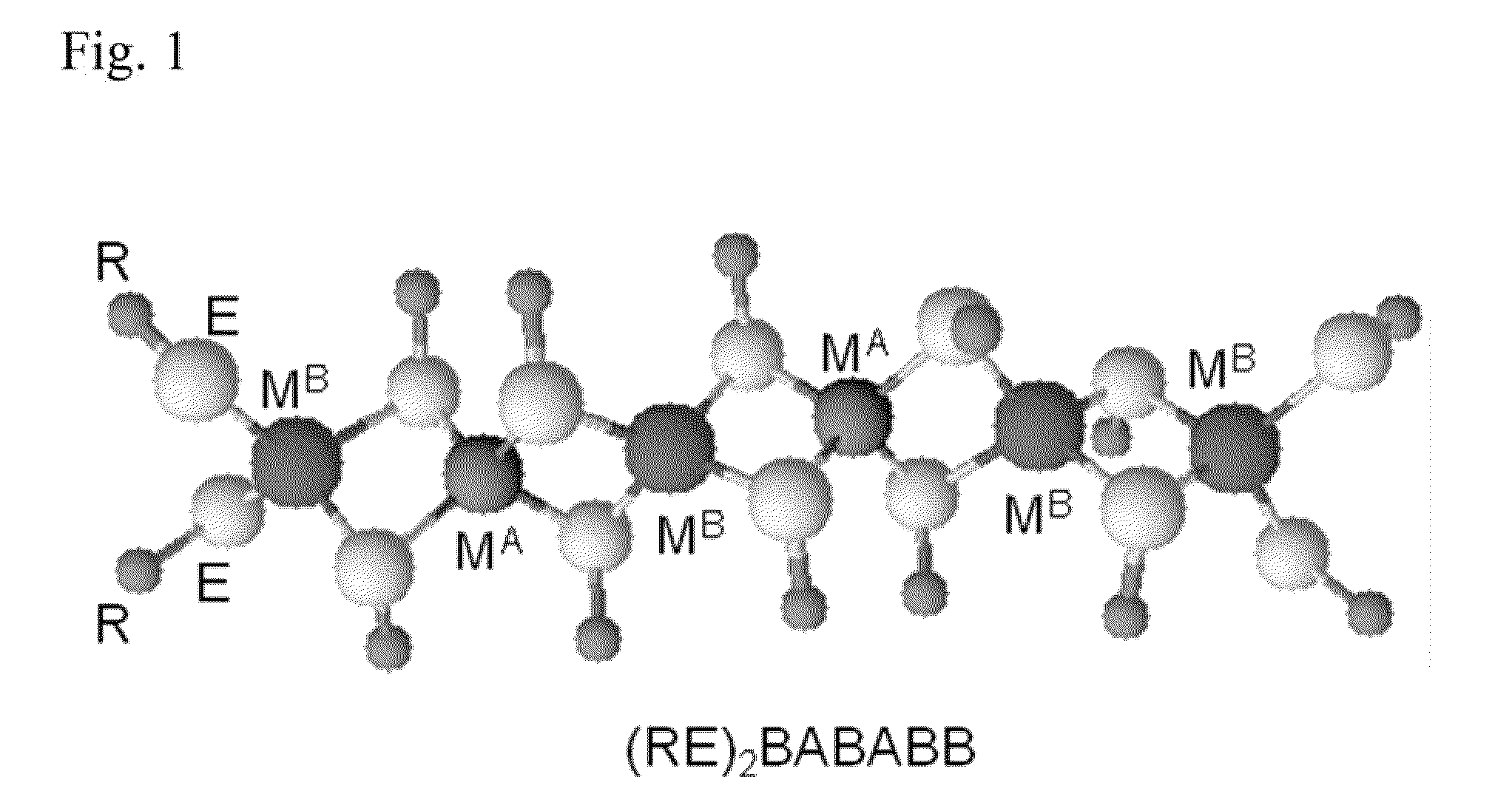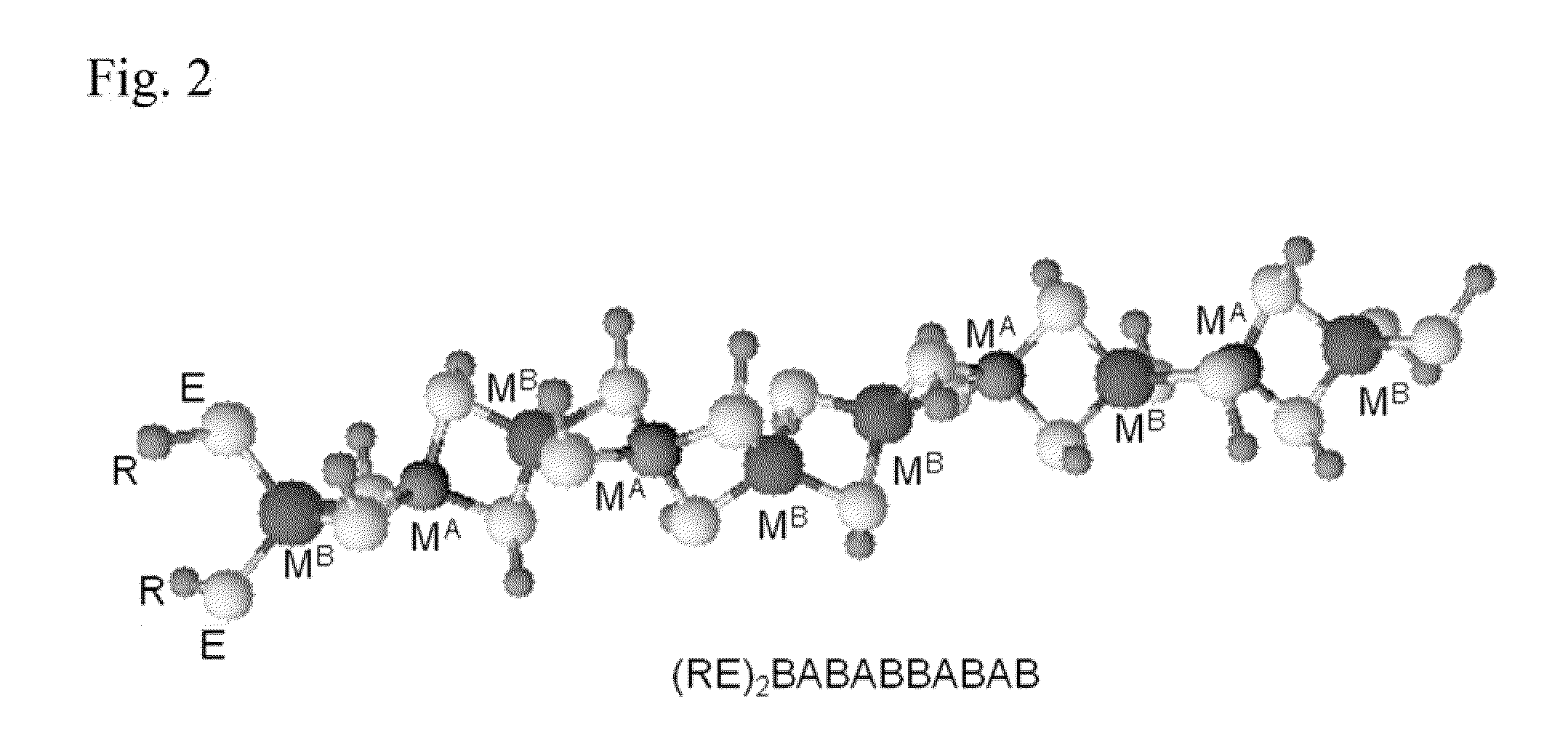Processes for polymeric precursors for caigas aluminum-containing photovoltaics
a technology of photovoltaics and precursors, applied in the field of polymeric precursors, can solve the problems of lack of uniformity of cigs layers, complex cigs materials, and limited use of optoelectronic or solar cell products
- Summary
- Abstract
- Description
- Claims
- Application Information
AI Technical Summary
Benefits of technology
Problems solved by technology
Method used
Image
Examples
example 1
Preparation of Polymeric Precursor Compounds and Compositions
[0516]An MPP-CAIGAS polymeric precursor represented by the formula {Cu0.7Ag0.25 (SesBu)3.95In0.3Ga0.4Al0.3} was synthesized using the following procedure.
[0517]In an inert atmosphere glovebox, a Schlenk tube was charged with 0.31 g (0.6 mmol) of In(SesBu)3, 0.38 g (0.8 mmol) of Ga(SesBu)3, 0.26 g (0.6 mmol) of Al(SesBu)3, 0.28 g (1.4 mmol) of CuSesBu and 0.12 g (0.5 mmol) of AgSesBu. Benzene (30 mL) was added, and the reaction mixture was stirred at 25° C. for 12 hr. A light yellow solution was obtained. The solvent was removed under reduced pressure and pentane (30 mL) was used to extract the product. The resulting solution was filtered through a filter cannula and the volatiles were subsequently removed under reduced pressure. 1.26 g (93%) of yellow oil was obtained.
[0518]Elemental analysis: C, 26.7, H, 5.07. NMR: (1H) 1.06 (br), 1.80 (br), 2.12 (br), 3.75 (br) in C6D6.
[0519]As shown in FIG. 8, the TGA for this MPP-CAIGA...
example 2
[0520]An MPP-CAGAS polymeric precursor represented by the formula {Ga0.5Al0.5(SesBu)3.9Cu0.5Ag0.4} was synthesized using the following procedure.
[0521]In an inert atmosphere glovebox, a Schlenk tube was charged with 0.48 g (1.0 mmol) of Ga(SesBu)3, 0.44 g (1.0 mmol) of Al(SesBu)3, 0.20 g (1.0 mmol) of CuSesBu and 0.20 g (0.8 mmol) of Ag(SesBu)3. Benzene (30 mL) was added, and the reaction mixture was stirred at 25° C. for 12 hr. A brown solution was obtained. The solvent was removed and pentane (30 mL) was used to extract the product. The resulting solution was filtered through a filter cannula and the volatiles were subsequently removed under reduced pressure. 1.12 g (85%) of yellow oil was recovered.
[0522]NMR: (1H) 1.07 (br), 1.81 (br), 2.17 (br), 3.77 (br) in C6D6.
[0523]As shown in FIG. 9, the TGA for this MPP-CAGAS polymeric precursor showed a transition beginning at about 61° C., having a midpoint at about 201° C., and ending at about 236° C. The yield for the transition was 43...
example 3
[0524]An MPP-CAIAS polymeric precursor represented by the formula {Cu0.5Ag0.5(SesBu)4In0.7Al0.3} was synthesized using the following procedure.
[0525]In an inert atmosphere glovebox, a Schlenk tube was charged with 0.37 g (0.7 mmol) of In(SesBu)3, 0.13 g (0.3 mmol) of Al(SesBu)3, 0.10 g (0.5 mmol) of CuSesBu and 0.12 g (0.5 mmol) of AgSesBu. Benzene (20 mL) was added, and the reaction mixture was stirred at 25° C. for 12 hr. A light yellow solution was obtained. The solvent was removed under reduced pressure and pentane (30 mL) was used to extract the product. The resulting solution was filtered through a filter cannula and the volatiles were then removed under reduced pressure. 0.62 g (86%) of yellow oil was obtained.
[0526]Elemental analysis: C, 23.6, H, 4.82. NMR: (1H) 1.06 (br), 1.81 (br), 2.12 (br), 3.73 (br) in C6D6.
[0527]As shown in FIG. 10, the TGA for this MPP-CAIAS polymeric precursor showed a transition beginning at about 165° C., having a midpoint at about 210° C., and end...
PUM
| Property | Measurement | Unit |
|---|---|---|
| Temperature | aaaaa | aaaaa |
| Fraction | aaaaa | aaaaa |
| Fraction | aaaaa | aaaaa |
Abstract
Description
Claims
Application Information
 Login to View More
Login to View More - R&D
- Intellectual Property
- Life Sciences
- Materials
- Tech Scout
- Unparalleled Data Quality
- Higher Quality Content
- 60% Fewer Hallucinations
Browse by: Latest US Patents, China's latest patents, Technical Efficacy Thesaurus, Application Domain, Technology Topic, Popular Technical Reports.
© 2025 PatSnap. All rights reserved.Legal|Privacy policy|Modern Slavery Act Transparency Statement|Sitemap|About US| Contact US: help@patsnap.com



